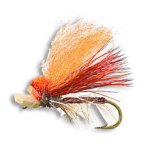PACOFRANSICO
Active member
- Joined
- Jan 7, 2010
- Messages
- 1,119
Hey I've bin on a emerger kick for a couple of days. And I tyied a new version of a pattern I was trying to dial in last year. This is the first anyone has seen it. Be brutally honest. I don't have a name for it so if ya have any suggestions....
Matrerials.
1. Mustad model 94845 #16
2. Partridge neck
3. Brown wapsi dubbin (nymph)
4. Coastal deer hair
5. Furnace hackle
6. brn. 140 ultra thread
7. 2MM brown foam
STEPS
1. Tie in your prtridge feather 1/3 the shank lenght

2. Dub 1/3 the way up shank building a tapered body like you would on a hares ear.

3. Cut the thinist piece of foam you can tie it in pointing backwards. wrap it forward 2 or 3 times til body look uniform.

4. Clip about 20 strans of the coastal deer hair. tye it in with the tips facing forward and so the tips are a 1/4 in pat the hook eye. Keep th hair from spinning. You want it to flare right over the eye of the hook. Make a couple wraps between the tips and the eye to stand the hair up and keep it outta your way while threading your tippet. Clip the butts of the hair.

5. Tye in your hackle on your thread that you flared your deer hair.

6. Wrap the hackle a good 5 to 6 turns. Or what ever you thinks looks good. and whip finish behind the deer hair tips.

Matrerials.
1. Mustad model 94845 #16
2. Partridge neck
3. Brown wapsi dubbin (nymph)
4. Coastal deer hair
5. Furnace hackle
6. brn. 140 ultra thread
7. 2MM brown foam
STEPS
1. Tie in your prtridge feather 1/3 the shank lenght

2. Dub 1/3 the way up shank building a tapered body like you would on a hares ear.

3. Cut the thinist piece of foam you can tie it in pointing backwards. wrap it forward 2 or 3 times til body look uniform.

4. Clip about 20 strans of the coastal deer hair. tye it in with the tips facing forward and so the tips are a 1/4 in pat the hook eye. Keep th hair from spinning. You want it to flare right over the eye of the hook. Make a couple wraps between the tips and the eye to stand the hair up and keep it outta your way while threading your tippet. Clip the butts of the hair.

5. Tye in your hackle on your thread that you flared your deer hair.

6. Wrap the hackle a good 5 to 6 turns. Or what ever you thinks looks good. and whip finish behind the deer hair tips.





